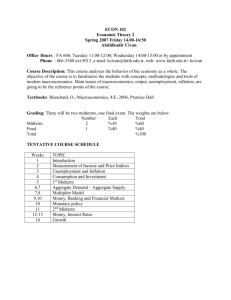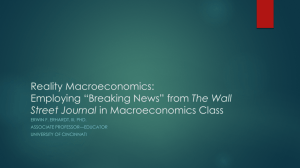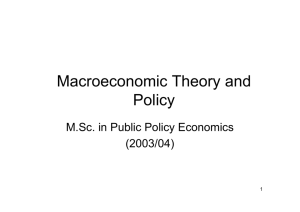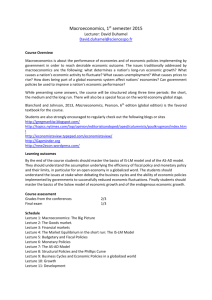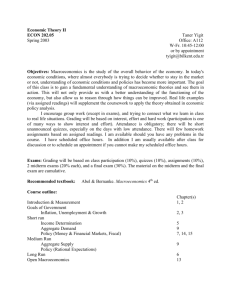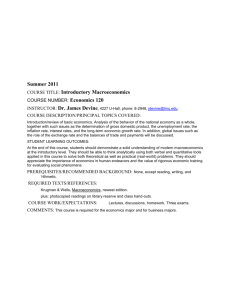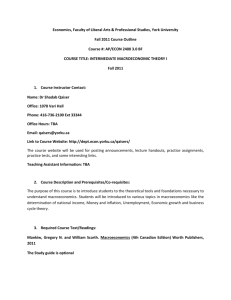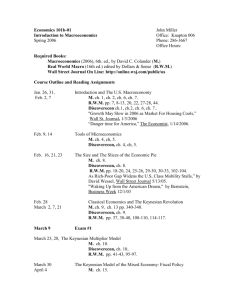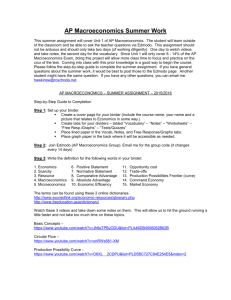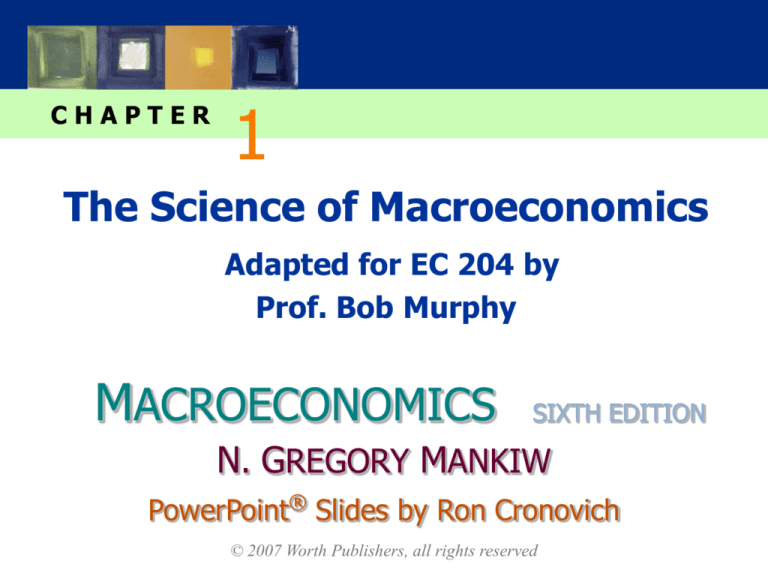
CHAPTER
1
The Science of Macroeconomics
Adapted for EC 204 by
Prof. Bob Murphy
MACROECONOMICS
SIXTH EDITION
N. GREGORY MANKIW
PowerPoint® Slides by Ron Cronovich
© 2007 Worth Publishers, all rights reserved
Learning Objectives
This chapter introduces you to
the issues macroeconomists study
the tools macroeconomists use
some important concepts in macroeconomic
analysis
CHAPTER 1
The Science of Macroeconomics
slide 1
Important issues in
macroeconomics
Macroeconomics, the study of the economy as
a whole, addresses many topical issues:
Why does the cost of living keep rising?
Why are millions of people unemployed,
even when the economy is booming?
What causes recessions?
Can the government do anything to combat
recessions? Should it?
CHAPTER 1
The Science of Macroeconomics
slide 2
Important issues in
macroeconomics
Macroeconomics, the study of the economy as
a whole, addresses many topical issues:
What is the government budget deficit?
How does it affect the economy?
Why does the U.S. have such a huge trade
deficit?
Why are so many countries poor?
What policies might help them grow out of
poverty?
CHAPTER 1
The Science of Macroeconomics
slide 3
U.S. Real GDP per capita
(2000 dollars)
40,000
9/11/2001
First oil
price shock
30,000
long-run upward trend…
20,000
Great
Depression
Second oil
price shock
10,000
World War II
0
1900 1910 1920 1930 1940 1950 1960 1970 1980 1990 2000
CHAPTER 1
The Science of Macroeconomics
slide 4
U.S. inflation rate
(% per year)
25
20
15
10
5
0
-5
-10
-15
1900 1910 1920 1930 1940 1950 1960 1970 1980 1990 2000
CHAPTER 1
The Science of Macroeconomics
slide 5
U.S. unemployment rate
(% of labor force)
30
25
20
15
10
5
0
1900 1910 1920 1930 1940 1950 1960 1970 1980 1990 2000
CHAPTER 1
The Science of Macroeconomics
slide 6
Why learn macroeconomics?
1. The macroeconomy affects society’s well-being.
Each one-point increase in the unemployment rate
is associated with:
920 more suicides
650 more homicides
4000 more people admitted to state mental
institutions
3300 more people sent to state prisons
37,000 more deaths
increases in domestic violence and homelessness
CHAPTER 1
The Science of Macroeconomics
slide 7
Why learn macroeconomics?
change from 12 mos earlier
5
In most years, wage growth falls 5
when unemployment is rising.
4
3
3
1
2
1
-1
0
-3
-1
-5
-2
-3
1965
-7
1970
1975
1980
1985
1990
1995
2000
2005
percent change from 12 mos earlier
2. The macroeconomy affects your well-being.
unemployment
rate
mean wage (right scale) slide 8
CHAPTER
1 The Science
ofinflation-adjusted
Macroeconomics
Why learn macroeconomics?
3. The macroeconomy affects politics. See Supplement 1-2.
Unemployment & inflation in election years
year
U rate
inflation rate
elec. outcome
1976
7.7%
5.8%
1980
7.1%
13.5%
Reagan (R)
1984
7.5%
4.3%
Reagan (R)
1988
5.5%
4.1%
Bush I (R)
1992
7.5%
3.0%
Clinton (D)
1996
5.4%
3.3%
Clinton (D)
2000
4.0%
3.4%
Bush II (R)
2004
5.5%
3.3%
Bush II (R)
Carter (D)
2008
CHAPTER 1 5.8%
The Science of 1.1%
MacroeconomicsObama (D)
slide 9
Economic models
…are simplified versions of a more complex reality
irrelevant details are stripped away
…are used to
show relationships between variables
explain the economy’s behavior
devise policies to improve economic
performance
CHAPTER 1
The Science of Macroeconomics
slide 10
Endogenous vs. exogenous
variables
The values of endogenous variables
are determined in the model.
The values of exogenous variables
are determined outside the model:
the model takes their values & behavior
as given.
In a model of supply & demand for cars,
endogenous:
exogenous:
CHAPTER 1
P , Qd , Qs
Y , Ps
The Science of Macroeconomics
slide 11
A multitude of models
No one model can address all the issues we
care about.
e.g., our supply-demand model of the car
market…
can tell us how a fall in aggregate income
affects price & quantity of cars.
cannot tell us why aggregate income falls.
CHAPTER 1
The Science of Macroeconomics
slide 12
A multitude of models
So we will learn different models for studying
different issues (e.g., unemployment, inflation,
long-run growth).
For each new model, you should keep track of
its assumptions
which variables are endogenous,
which are exogenous
the questions it can help us understand,
and those it cannot
CHAPTER 1
The Science of Macroeconomics
slide 13
Prices: flexible vs. sticky
Market clearing: An assumption that prices are
flexible, adjust to equate supply and demand.
In the short run, many prices are sticky –
adjust sluggishly in response to changes in
supply or demand. For example,
many labor contracts fix the nominal wage
for a year or longer
many magazine publishers change prices
only once every 3-4 years
CHAPTER 1
The Science of Macroeconomics
slide 14
Prices: flexible vs. sticky
The economy’s behavior depends partly on
whether prices are sticky or flexible:
If prices are sticky, then demand won’t always
equal supply. This helps explain
unemployment (excess supply of labor)
why firms cannot always sell all the goods
they produce
Long run: prices flexible, markets clear,
economy behaves very differently
CHAPTER 1
The Science of Macroeconomics
slide 15
Outline of this book:
Introductory material (Chaps. 1 & 2)
Classical Theory (Chaps. 3-6)
How the economy works in the long run, when
prices are flexible
Growth Theory (Chaps. 7-8)
The standard of living and its growth rate over the
very long run
Business Cycle Theory (Chaps. 9-13)
How the economy works in the short run, when
prices are sticky
CHAPTER 1
The Science of Macroeconomics
slide 16
Outline of this book:
Policy debates (Chaps. 14-15)
Should the government try to smooth business
cycle fluctuations? Is the government’s debt a
problem?
Microeconomic foundations (Chaps. 16-19)
Insights from looking at the behavior of
consumers, firms, and other issues from a
microeconomic perspective
CHAPTER 1
The Science of Macroeconomics
slide 17

